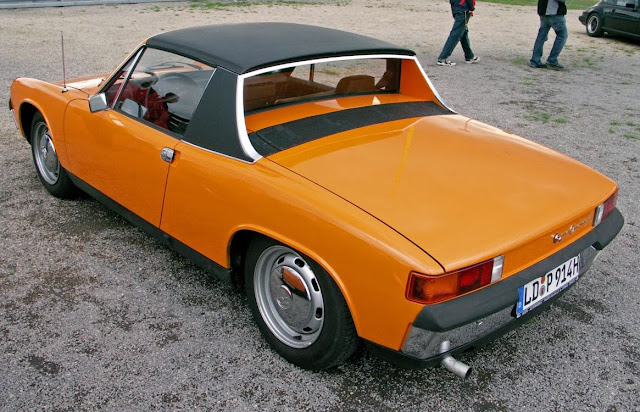The Porsche 914, alias VW-Porsche 914 (as it was called in Europe) was marketed 1969-1974. At the time, both Volkswagen and Porsche featured rear-mounted air-cooled motors, but the 914's air-cooled motor (borrowed from the Vokswagen
411 or Series 4) was mounted racing car style, in the middle, ahead of the rear axle.
The Wikipedia entry on the 914 is
here and a fairly detailed history can be linked
here. The latter reminds us that mid-mounted engines work well for racers, but are problematical for passenger cars. This design decision certainly forced the 914's planners to come up with creative spatial arrangement solutions. For example, the car had two trunks, one at each end. The rear trunk was sized and shaped to house the car's detachable Targa roof. This was held in place by four clips that, when released, allowed one person to lift the roof off and place it in the rear trunk with the side effect of somewhat reduced storage capacity. In any case, these dimensional requirements affected the car's proportions and styling.
As for the interior, the passenger seat's back was fixed against the engine firewall; a movable footrest was provided to aid comfort. The driver's seat was adjustable. The seating position in both was very close to the ground, legs being stretched out. Nevertheless, this was comfortable for long-distance driving.
Gallery
Shown above is Ferry Porsche next to what might be a 916 (the 6-cylinder Porsche engined version of the 914) or even perhaps an experimental 8-cylinder version.
This is the European version of the 914. Note that the hub caps have the VW symbol; cars sent to North America had Porsche markings. Entry level 914s lacked the chrome bumpers and vinyl cladding on the Targa bar.
This 914 has the painted bumper.
A profile view. Here you can compare the length of the top and rear trunk. which begins just aft of the Targa bar.
As can be seen in this view, the rear window is essentially vertical. It was fixed, not able to be rolled down. The dark area between it and the trunk is the air intake for the air-cooled motor.
The 914's headlights rotated up when turned on. This did nothing for its aerodynamic efficiency.
I include this image because it provides a sense as to how small and low 914s were.
Another view providing scale.
You might be wondering why all the 914s shown above are painted that orange-gold color or something similar. That's because orange-gold was the color of my 1971 model 914.
Due to the requirements of its mid-placement of the motor and roof storage, 914's began with a proportional handicap that created difficulties for stylists. I consider it awkward, rather than ugly. I also think a few detail changes might have improved it looks a bit, though beauty was probably doomed from the start.




++-+1938.jpg)





+-+1951.jpg)




































